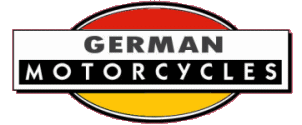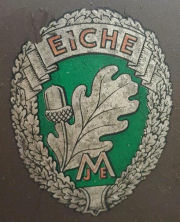

This page lists brand names beginning with the letter "E" for which we currently have only an historical precis.
For a more complete listing visit the German Index.
Eber
Built by Eber Motorradbau, Eibau (Sachsen), 1924-1928
Used 347cc and 497cc engines from JAP and Blackburne, and later ohv Kühne and ohc Küchen.
Sources: GTU Oldtimerservice, Tragatsch p124.
EBS 1924-1930
EBW
Manufactured by Erich Büscher GmbH
Berlin-Wilmersdorf, Uhlandstrasse 121, 1924 to 1926.
The first EBW motorcycles were fitted with 2 h.p. four-stroke engines. In 1925 a model with a 150cc AZA-JAP two-stroke was introduced with a three-speed gearbox and chain drive to the rear wheel. Another EBW model had a Bekamo engine and qualified for the tax-free category.
Motorycle production is thought to have ceased in late 1925 or early 1926. The company continued trading until 1929.
Sources: Tragatsch p125; Motopedia.
ECA
1923-1924
Built 142cc 1.5ps two-stroke motorcycles. Limited production.
Source: Tragatsch p125
Eceka
Manufactured by Emil C. Kretzschmar, Berlin, 1924-1925
The Eceka light motor was offered with the option of a 145cc or 173cc engine produced by Richard Gruhn of Berlin, with component parts from Charlett and Kurier. The frames were apparently from Gruhn's brother Hugo who supplied many other Berlin motorcycle manufacturers.
Kretzschmar was a partner in Eisenhammer firm, so it is very possible that some of the Eceka machines were built by them.
Sources: GTU Oldtimerservice, Tragatsch p125
Eckl
1923-1926
Hugo Eckl built bicycle attachment engines and later a 198cc ohv engine which powered his own lightweight motorcycles.
Source: Tragatsch p125
ECO
Manufactured by E. Coquelin, Mechaniker
Kaiserswertherstraße 2, Ratingen, 1922-1926
The firm opened in 1920, and advertised the ECO in July 1922, powered by a 1 h.p. or 1½ h.p. DKW engine.
In 1925 they advertised an ECO with a 2.5 h.p. DKW engine, two-speed gearbox, clutch, kick-starter and lighting. 1926 was the last year the brand appeared in the trade press.
Source: Motopedia
ED by Eberwein & Diener 1925~1927
Efka Sidecars
Manufactured by Fritz Karsten, Berlin, 1929~1933
Sources: vorkriegs-seitenwagen.de by Frank Gruneboom; Das Motorrad.
ef-tech
Jochen Brett ef-tech, Hillerstr. 10, D-75417 Mühlacker-Mühlhausen
Constructs sidecar combinations using BMW and Moto-Guzzi motorcycles and Russian and Chinese sidecars. Has a long history in the trade, much of it outlined here: ef-tech.de/uber-uns
EGA
Manufactured by Eisenwerke Gaggenau AG, 1923-1925
Formed in 1888, the company produced kitchen stoves, water heaters and bicycles. The large factory had 50 buildings along with 87 appartments for its workforce and their families. They employed 2,200 people.
The 246 and 346cc models had two-stroke engines of their own construction with two-speed gearboxes, very heavily ribbed cylinders and alloy cylinder heads. The EGA 03 model had a three-speed gearbox and chain drive to the rear wheel. They also built a small capacity model named Gaggenau UM 1 which was similar in style to the Evans-Pondorf.
Although the EGA was one of the best two-stroke engines of the time, it was not produced in significant quantities. In 1925, production of the EGA was discontinued. Early the following year the company stood down the entire workforce.
Eichler & Co. had been marketing the EGA under the name Gaggenau, and it would appear that they bought the remaining EGA stock.
An example of an EGA Gaggenau motorcycle has been displayed at the Unimog Museum in Gaggenau.
Sources: GTU Oldtimerservice; Tragatsch p125; Motopedia
N.B. There was also an EGA marque built the Netherlands in the 1980s.

Eiche
Manufactured by Johann Eickhaus, Moers, 1950s
Began trading as a bicycle wholesaler in Moers in 1919, and later also sold motorcycles. The firm built (or possibly sold rebadged) mopeds in the 1950s.
Johann Eickhaus was born on March 11, 1887 in Vluyn, today Neukirchen-Vluyn, and died on February 20, 1962 in Moers.
Source: Farben-Schiessl.
Eichelsdörfer
Manufactured 1929-1932
Willy & Josef Eichelsdörfer, Nuremberg
Constructed motorcycles using smaller JAP ohv (and possibly sidevalve) engines and Burman gearboxes along with other British components including Druid forks. They were hand-built and apparently of very good quality.
Source: meisterdinger.de, Tragatsch p125
Eisenhammer 1923-1926
Ekamobil 1908-1914
Elfamo
Manufactured by Cyklop-Fahrrad-AG, later Elfamo Elsdorfer Fahrzeug- und Motorenwerk AG
Elsdorf (Rheinland), 1923 to 1926
Founded in late 1921 as a bicycle manufacturer with Peter Braun as director. Braun had been head of Bünnagel & Co. GmbH of Elsdorf in 1921 which built motorised bicycles powered by Snob engines.
In the first half of 1923 Dallmann & Co. of Düsseldorf, general agent for Cyklop, exhibited the Elfa motorised bicycle built by Cyklop-Fahrrad-AG. In May of that year Dallmann offered its own Dalli brand motor bicycles which had a Hansa engine mounted in a Cyklop frame.
In May 1924, the Cyklop company was renamed Elfamo (Elsdorfer Fahrzeug- und Motorenwerk AG) and had added engines and motor vehicles to its product line. Elfamo motorcycles appeared in racing events in the 175cc and 350cc classes, and some of the machines were possibly powered by JAP engines.
By this time the financial crisis in Germany was taking its toll, and the company was losing money fast. It ceased trading in 1926 and was dissolved in 1927.
Source: Motopedia
Elfe 1923-25
Elster
1923-1924
Elster-Werke GmbH of Mylau built light motorcycles powered by 197cc engines designed and built in-house.
Their model EW 23 light motorcycle powered by 197cc engine, probably built in of 1923, was eligible for tax-free concessions.
Model F 25 for the 1925 season had a two-speed gearbox, kickstarter, and clutch. These were distributed in Dresden by the Curt Borrmann concern.
It is likely that production ceased in late 1924.
Sources: Tragatsch p126; Motopedia.
EMA
Manufactured by Eduard Molito of Aalen from 1922 to 1925 using two-stroke engines from DKW, some of which may have been 148cc horizontal types.
Sources: Tragatsch p126, period advertising.
E.M.A.G.
Manufactured by Erlanger Motoren Aktiengesellschaft of Erlangen 1923-c1932
Early in the piece the brand name was changed to Ermag.
Designed by Albert Roder, who is also credited with the Ziro
and the NSU Max, the firm produced high-performance OHV engines with hairpin valve springs.
Source: deacademic.com
Emefbe
Built in Leipzig around 1924, these were lightweight motorcycles advertised as Leichtkraft-Räder and fitted with engines of up to 200cc.
Source: motorräder-aus-leipzig.de
EMH
Manufactured by Motorradbau Ernst Megg, Hamburg, from 1927 to 1929.
These were sports machines powered by OHC engines of 348 and 498cc built by Kürchen.
Source: Tragatsch p126
E.M.W. (Leipzig) 1925~1930
EMWE
1924-1925. EMWE Motoren-Gesellschaft, Stettin, Barnimstraße 17. Built motorcycles using a welded box frame fitted with a 293cc two-stroke engine of their own design.
Sources: Tragatsch p127, prawobrzeze.eu
ENAG
Manufactured by Erle & Nestler AG, Maschinenfabrik, Nuremberg, 1924-1926
Built motorcycles powered by their own 248cc and 348cc two-stroke engines which had water-cooled cylinders and air-cooled cylinder heads. Chain drive via two-speed and three-speed gearbox was adopted in 1925. The engines were designed by Theo Steininger.
In 1925 they acquired Sept & Unger and built a few machines under that brand.
NB. GTU gives dates of 1923-1925
Source: meisterdinger.de, GTU Oldtimerservice, Tragatsch p127
Engel
Manufactured by Gustav Engel Söhne, Motorfahrzeugbau, Merseburg
Production began in 1925, just as hyperinflation began to bite, of comparitively expensive 350cc machines with engines from Kühne. As did a large number of other small manufacturers, the factory closed the same year.
Engel is German for Angel.
Source: wikipedia.nl, Tragatsch p127 (referred to as Engee)
EO (Elite-Opel)
1930-1931 or 32.
Very similar in appearance to the Opel, it used a Duralumin frame designed by Newmann-Neander fitted with 348cc and 498cc ohc Kurchen engines. Very few were built.
See also Elite.
Source: Tragatsch p127
EPA 1924-1929
ERAD
Engines were supplied by Esbe in the mid-1920s, and possibly by Abako.

Erasmus & Willms
Adalbertsteinweg 26, Aachen
On the first day of January, 1922, the sales and repair shop opened. They became sole agent for Helios in Munich.
The following year they were distributors for Sarolea motorcycles in the Aachen region, and were advertising Rush motorcycles, also from Belgium.
1926 saw the construction of an "Erasmus & Willms" motorcycle which was entered in a number of races, with some success. By 1928 the company focus had shifted to mechanical engineering, and continued along those lines in the post-war period.
Over a century later the business was still operating.
Sources: Motopedia, et al
Ergo
Manufactured by Hilmar Linker at Jägerstraße 15, Leipzig-Gohlis from 1924 to 1925.
A motorcycle with a 346cc ohv single-cylinder engine was produced but it was of awkward design and did not fare well in the marketplace. Linker-built 250 and 350cc machines competed in events such as the Marienberger Dreieck.
Sources: motorräder-aus-leipzig.de, wikipedia.de.
Erka
1924-25
269cc two-stroke machine built in small numbers.
Source: Tragatsch p127
Erko
1922-24
Built a modest numbers of DKW-powered 145cc two-stroke machines.
Source: Tragatsch p127
Ermag 1923-1930

eRockit
"eROCKIT combines eBikes, bicycles and motorcycles in a whole new dimension. The Hyperbike Made in Germany."
erockit.de
facebook.com/eROCKITGermany#
Eichler & Bachmann 1923-1927 (Eibach)
Ernst-MAG 1926-1930
Esbe
Engine builder who supplied 130cc and 160cc two-strokes to firms such as GE MA HI, JOKA, ERAD and others in the mid-1920s.
Source: motor-hist-foto.de
Eschag
Manufactured 1923-1925, Nuremburg
The firm built motorcycles with 298cc two-stroke engines and belt drive.
Source: meisterdinger.de
Esch-Record 1927-1930
Europa
Manufactured by Europa Motorenbau, Munich, 1931-1933
Vorbauer & Reichenwallner of Landwehrstrasse in Munich, established in 1919, sold Dixi bicycles. Max Vorbauer was a keen cyclist who was responsible for the construction of a board cycling track in Munich.
Around 1930 Max Vorbauer formed his own company which sold and distributed to other dealers Coventry-Eagle and New Imperial motorcycles. He also marketed Kolibri bicycle engines, available as a complete Dixi motorised bicycle.
Early in 1931 they ceased importing Coventry-Eagle and began distributing Mammut motorcycles which were similar in design to the English machines. Later that year Vorbauer began producing, under licence, the Coventry-Eagle Marvel, a lightweight powered by a 98cc Villiers two-stroke engine which he marketed under the Europa brand. This model was available until early 1933.
January 1932 saw the introduction of the Europa 150 powered by the 148cc Villiers Mk XIIC. Fitted with a Hurth three-speed gearbox, it had both kickstarter and clutch. Later models had a saddle tank.
The following year the Europa 200 was added to the range, but disaster struck when the National Socialist government banned the import of the English engines. It is possible that Vorbauer fitted Schliha two-strokes in an attempt to survive, but bankruptcy ensued later in 1933.
Sources: GTU Oldtimerservice; Tragatsch p 129; Motopedia.
Evans-Pondorf
Manufactured in Berlin 1924-1925 based on the Evans machine from the United States, but with several improvements and a larger engine. It remained in production until 1925.
European manufacturers and agents for Evans Motorcycles
Source: GTU Oldtimerservice
EVO
1923-1925
Designed and built by Eduard Voight of Hannover, well-known as a writer for motorcycle journals, these light motorcycles were powereed by 146cc JLO engines along with those of their own manufacture.
Source: Tragatsch p129
Ewabra
Manufactured in Milspe, Westphalia, 1921-1924
Ewald Brackelsberg, a cousin of Bugatti racer Karl Brackelsberg, produced a 550cc single.
Their designer, Otto Karpe, went on to become a major player with Tornax.
Sources: GTU Oldtimerservice; tornaxig.de; Tragatsch p129.
Excelsior
Manufactured 1923-1924
This small firm in Munich built 245cc two-strokes. Unrelated to the long-established Excelsior of Brandenburg.
Source: Tragatsch p131
There were two German marques with this name: see Disambiguation
Rarer German Marques